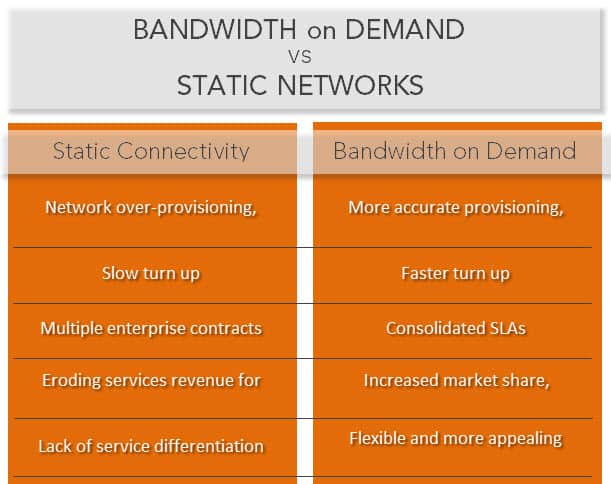In the rapidly evolving landscape of networking, Bandwidth on Demand (BoD) emerges as a pivotal concept, adapting to the ever-increasing and fluctuating data requirements of modern technologies. This concept, rooted in the flexibility and efficiency of network resource management, has transformed significantly from its early days. In this article, we’ll embark on a journey to unravel the intricacies of Bandwidth on Demand. We start by defining what BoD is and how it has evolved from its inception to the present day. Moving forward, we’ll delve into the mechanics of how BoD operates in contemporary networking environments, discussing its various applications and implications. We’ll also weigh its advantages against its potential drawbacks, providing a balanced view of this dynamic technology. This exploration aims to offer a comprehensive understanding of Bandwidth on Demand, underscoring its critical role in today’s data-driven world.
Table of Contents:
- What is Bandwidth on Demand?
- Historical Evolution of Bandwidth on Demand
- How Bandwidth on Demand Works Today
- Applications of Bandwidth on Demand in Modern Networking
- Advantages of Bandwidth on Demand
- Conclusion
- References

1. What is bandwidth on Demand?
Bandwidth on Demand refers to the ability of a network to provide flexible bandwidth allocation based on current data transmission needs. This dynamic approach to bandwidth management allows networks to adjust their capacity in real-time, catering to varying user demands and application requirements. Unlike static bandwidth allocation, where the bandwidth capacity is fixed regardless of actual usage, BoD is inherently adaptive. It ensures that network resources are efficiently utilized, preventing both underuse and overload of network capacities.
At its core, BoD is about optimizing network performance and cost-effectiveness. It achieves this by automatically scaling bandwidth up or down, aligning with the fluctuating nature of network traffic. This scalability is crucial in modern networking scenarios, where data demands can change rapidly due to varied factors like user behavior, time of day, or specific events.

2. Historical Evolution of Bandwidth on Demand
The concept of Bandwidth on Demand has its roots in the early days of the internet, where network resources were significantly more limited than today. Initially, BoD was about managing scarce bandwidth resources efficiently, especially in technologies like Integrated Services Digital Network (ISDN) and Broadband ISDN (B-ISDN). These early implementations focused on providing additional bandwidth when needed, albeit within the constraints of the technology available at the time.
As internet technology evolved, so did the meaning and application of BoD. The advent of broadband and the exponential increase in data traffic led to more sophisticated and automated ways of managing bandwidth. The shift from a scarcity of bandwidth to an era of abundant, yet still finite, network resources transformed BoD into a more dynamic, responsive mechanism, integral to modern network management.
3. How Bandwidth on Demand Works Today
Current Technologies Enabling BoD
Today, Bandwidth on Demand (BoD) is made possible by advanced networking technologies such as Software-Defined Networking (SDN) and Network Functions Virtualization (NFV).
- Software-Defined Networking (SDN): SDN has revolutionized how network management and operation are carried out. By separating the network’s control logic from the underlying hardware, SDN provides a more flexible and efficient approach to managing network resources. This separation allows for dynamic adjustment of bandwidth on a per-need basis. With SDN, network administrators can programmatically control network traffic and adjust bandwidth according to real-time data demands.
- Network Functions Virtualization (NFV): NFV complements SDN by abstracting network functions from hardware to software. This abstraction allows for more agile deployment and management of network services. NFV enables networks to quickly scale up or down, providing BoD capabilities that can adjust to varying traffic loads without the need for additional physical infrastructure.
Role of Algorithms and AI in Bandwidth Management
Algorithms and Artificial Intelligence (AI) play a crucial role in predicting and managing bandwidth needs in modern networks.
- Predictive Algorithms: These are used to analyze historical data and predict future network requirements. By understanding past network usage patterns, these algorithms can forecast periods of high demand and adjust bandwidth allocation proactively.
- AI in Bandwidth Management: AI technologies, particularly machine learning, are increasingly being employed to optimize network performance. AI can make real-time decisions about bandwidth allocation, ensuring optimal network performance and efficiency. It can also identify and respond to network anomalies, preventing potential bottlenecks or failures.
4. Applications of Bandwidth on Demand in Modern Networking
BoD in Cloud Computing, 5G Networks, and IoT
Bandwidth on Demand has significant applications in several modern networking environments:
- Cloud Computing: In cloud services, BoD is essential for handling fluctuating workloads. As cloud-based applications can experience sudden spikes in user traffic, BoD allows cloud providers to dynamically allocate bandwidth, ensuring consistent service quality.
- 5G Networks: The fifth generation of mobile networks, or 5G, promises higher speeds and lower latency. BoD in 5G networks is crucial for managing the varying bandwidth needs of numerous connected devices, especially with the rise of IoT and smart devices.
- Internet of Things (IoT): IoT devices often transmit large amounts of data. BoD ensures that these devices have sufficient bandwidth to operate efficiently, especially in scenarios where IoT device activities peak at different times.
Use Cases in Enterprise Networks, Data Centers, and CDNs
- Enterprise Networks: Businesses can use BoD to manage bandwidth for various applications, ensuring high priority tasks have sufficient resources while optimizing overall network utilization.
- Data Centers: Modern data centers, hosting a vast array of services and storing large volumes of data, rely on BoD to efficiently manage network traffic, ensuring high availability and performance.
- Content Delivery Networks (CDNs): CDNs use BoD to manage the delivery of large files and streaming content. By dynamically adjusting bandwidth, CDNs can ensure fast and reliable content delivery to users worldwide, irrespective of traffic spikes.
In conclusion, Bandwidth on Demand is a critical component in modern networking, providing the flexibility and efficiency needed to meet today’s diverse and dynamic data demands.
5. Advantages of Bandwidth on Demand
Benefits of Bandwidth on Demand
- Cost-Efficiency: One of the primary advantages of Bandwidth on Demand (BoD) is its ability to reduce costs. By allocating bandwidth based on actual usage, organizations can avoid overspending on unutilized network resources. This pay-as-you-go approach ensures that businesses pay only for the bandwidth they need, optimizing their investment in network infrastructure.
- Scalability: BoD offers unparalleled scalability, enabling networks to adapt quickly to changing requirements. This flexibility is particularly beneficial in environments with fluctuating bandwidth needs, such as seasonal businesses or event-driven usage spikes. It allows for easy scaling up or down, ensuring that the network can handle both sudden increases in demand and periods of low activity without the need for manual intervention.
- Improved User Experience: By dynamically adjusting bandwidth, BoD ensures that all applications and services have the necessary resources to function optimally. This leads to a smoother, more responsive user experience, particularly for bandwidth-intensive applications like video streaming, large file transfers, and cloud-based services.
Impact on Network Congestion and Service Quality
- Managing Network Congestion: BoD plays a critical role in alleviating network congestion. During peak usage times, additional bandwidth can be allocated to prevent bottlenecks, ensuring consistent network performance. Conversely, during off-peak hours, bandwidth can be reduced to conserve resources.
- Enhancing Service Quality: With BoD, service providers can guarantee higher service quality. By proactively managing bandwidth, they can ensure service reliability and availability, even under varying load conditions. This results in fewer service disruptions and a better overall experience for the end-user.
6. Conclusion
Bandwidth on Demand represents a significant advancement in the way we approach network management and optimization. Its adaptability to fluctuating data needs, cost-efficiency, and scalability are key benefits that make it indispensable in modern networking. BoD enhances user experience by ensuring that network resources are utilized efficiently, thereby improving service quality and reducing the likelihood of network congestion.
As networking technology continues to evolve, the significance of BoD in managing network resources becomes increasingly evident. Its role in enabling flexible, efficient, and user-centric network services will likely become more crucial as the demand for data and connectivity grows. Bandwidth on Demand is not just a feature of modern networks; it’s a cornerstone of how we will meet the challenges of our increasingly connected world.
7. References
- Books:
- “Computer Networks: A Systems Approach” by Larry L. Peterson and Bruce S. Davie.
- “Networking Essentials” by Jeffrey S. Beasley and Piyasat Nilkaew.
- RFCs: